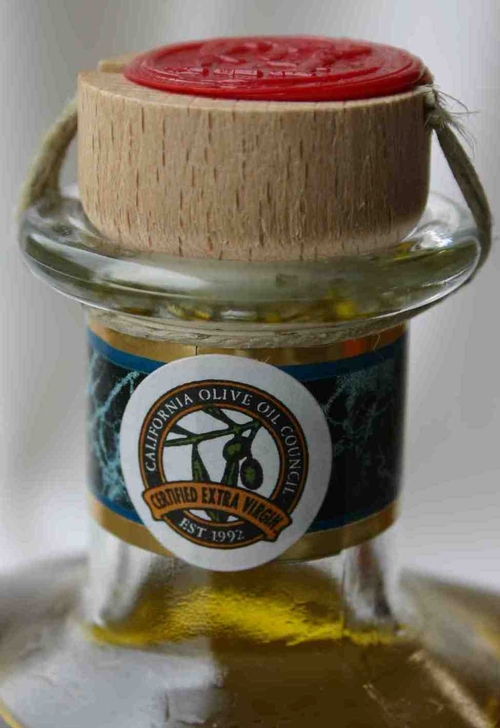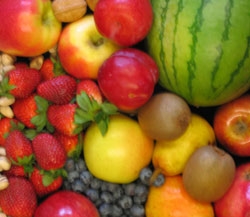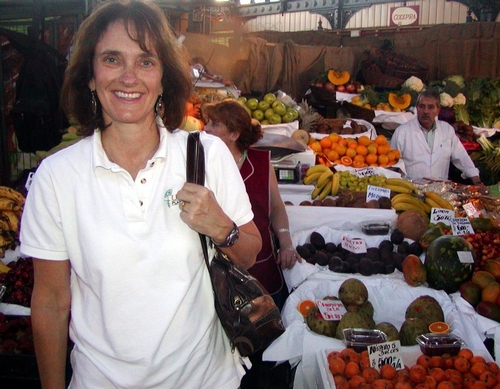Posts Tagged: flavor
'Extra virgin' olive oil: What is it and why does it matter?
Dipping fresh bread into olive oil has become a popular alternative to coating it with butter. Olive oil consists of 85 percent unsaturated fats, and when substituted for saturated fat in the diet can promote ”good” cholesterol (high density lipoprotein or HDL), reducing risk of coronary artery disease.
Some olive oils are more beneficial than others. "Extra virgin" olive oil (EVOO), for instance, is extracted from the olive fruit without using heat or chemical solvents. This mechanical process retains the highest amount of natural “phenolic compounds” — antioxidants and anti-inflammatory agents. Such compounds both retard oxidation in the olive oil (keeping it fresh and preventing rancidity) and confer health benefits.
Miller's diagram (above) depicts the fatty acid content of olive oil. PUFA is polyunsaturated fatty acids.
"Antioxidants combat cell and tissue damage due to oxidation, and anti-inflammatory agents reduce inflammation throughout the body. Inflammation can lead to an array of diseases (arthritis, coronary artery disease and more),” said Amy Myrdal Miller, registered dietitian and a program director at The Culinary Institute of America.
When oils are 'refined,' heat or chemical solvents strip away phenolic compounds; the result is often a bland flavor. Mechanically extracted "extra-virgin" oils retain aromatic components. Pungent, peppery and sometimes bitter notes signal that an oil contains phenolics.
The growth of premium olive oil production in California has its roots in 1997, when UC Cooperative Extension Sonoma County Advisor Paul Vossen started the first olive oil taste panel in California to help producers improve oil quality using sensory analysis. (See the January 2011 California Agriculture.)
When it comes to detecting positive and negative attributes of olive oil, human tasters are superior to current chemical analytical methods. Standards to define "extra-virgin" and other grades of oil include both sensory and laboratory measures. The International Olive Council's (IOC) narrow definition specifies that EVOO must show no evidence of heat or chemical solvents. It must have zero median "defects" (as judged by trained taste panels) and more than zero median fruitiness. It must meet requirements for low levels of free fatty acids (too many of these signal degradation) and peroxide levels (a sign of oxidation).
This definition has been adopted by the U.S. Department of Agriculture (USDA) and the states of California, Connecticut and Oregon. Beginning on Oct. 24 of 2010, it became part of new USDA standards for olive oil labeling, which also define "U.S. Virgin," "U.S. Refined" and other grades. Although the standards are voluntary, any manufacturer using this terminology on its label could be held to truth-in-labeling laws.
While the ultimate impact of the new USDA standards will take time, consumers can learn to identify flavor attributes of California olive oils by participating in tastings at vendors that feature artisan products. Also, the
California Olive Oil Council awards an extra-virgin certification seal to member oils that are defect-free.However, the array of olive oils now available at supermarkets can be daunting, and "extra virgin" on the label can be misleading. The UC Davis Olive Center reported in July 2010 that their samples from Sacramento, San Francisco and Los Angeles supermarkets revealed 69 percent of imported EVOO and 10 percent of California olive oil samples labeled as EVOO failed to meet International Olive Council (IOC)/USDA sensory standards for extra virgin olive oil.
Once you identify your favorite olive oil, it should be stored in a cool, dark environment, like a kitchen cabinet removed from the stove, according to Alexandra Vicenik Devarenne, freelance olive oil consultant in Sonoma County. Fluctuations in temperature and light affect the integrity of the health-promoting phenols in extra virgin olive oil.
“When people find out about phenolics and the effects of heat on olive oil, they may question whether it is safe and okay to cook with extra virgin olive oil,” she says. “The heat will destroy some of the health-promoting phenols in the oil, which will change the flavor. The longer the oil is exposed to heat, and the higher the heat, the more phenols will be destroyed.
“However, sautéing in extra virgin olive oil for 5 to 10 minutes over medium heat will have minimal effects on phenols and flavor.”
See more tips on storing and cooking with olive oil.
Reader expresses skepticism about flavor research
A recent Food Blog post about a new research effort aimed at improving the flavor of fruits and vegetables found in American grocery stores prompted a scornful e-mail from a reader.To whom it may concern, the letter-writer began, I find it appalling that $6 million is being spent to study something that any 3rd grader should be able to figure out.
The writer continued: "It is virtually impossible to enhance the flavor of an industrial farmed tomato because the flavor has been bred OUT of the varieties grown by big agriculture in favor of disease resistance and shelf stability. I can pick a green tomato from my yard and let it ripen on the counter and it will be delicious. That will just never be the case with most of the hybrids that have been developed over the past 20 years because flavor was NOT a priority. You can't add it in after the fact."
UC Davis Cooperative Extension specialist Beth Mitcham, director of the UC Davis Postharvest Technology Center, wrote the following response:"I agree with part of your comment but not entirely. It is true that breeders have focused for many years on yield, disease resistance and long shelf life. However, in recent years, breeders are paying more attention to flavor quality. As you mentioned, you can take a green tomato and ripen it into a great tasting tomato. I have also done this with tomatoes obtained from a commercial field.
"The problem with tomatoes harvested green and ripened after harvest is that the fruit are exposed to low temperatures. Studies have shown that exposure of tomatoes for just 24 hours to temperatures of 50 degrees reduces their flavor compounds by 50 percent. Most tomatoes are shipped to market at 45 to 50 degrees to reduce softening and decay. Another problem with green tomatoes and many other fruit is the maturity of the fruit at harvest. The earlier it is picked, the less flavor compounds the fruit will produce when it is fully ripe.
"This $6 million grant is focused on providing growers and shippers with the tools to successfully pick more mature or riper produce and deliver it to consumers with good flavor. We are refining technologies to sort the fruit by maturity and ripeness to remove the under-ripe and overripe fruit before shipment, better packaging to prevent bruising of softer, riper fruit during transport, methods to slow further ripening of riper fruit after harvest that may allow us to ship fruit at higher temperatures so that flavor is not lost.
"While you can always get the best flavor quality when you take a ripe product off the plant and eat it within a day, many US consumers do not have easy access to these products and most cannot get access year-round. While consumers recognize that fruits and vegetables are good for them, they only eat 2 to 3 servings per day (including French fries) instead of the 5 to 9 servings that are recommended. We believe that poor flavor contributes to low consumption. Our goal is to improve the flavor quality of fruits and vegetables available through your local grocery market so that consumers eat more – hopefully reaching the 5-a-day recommended for good health."
It looks great, but does it taste great?
Taking a look at melons, berries, tomatoes, pears, stone fruit, and more, researchers from UC Davis, along with collaborators from the University of Florida, are focusing on increasing consumption of specialty crops by enhancing quality and safety. Funded by the USDA, work on this Specialty Crops Research Initiative (SCRI) grant began about a year ago.
Americans, after years of hearing that fresh produce is valuable for numerous health benefits, have still not significantly increased their consumption. So, why don’t we eat more fruits and vegetables? Researchers believe that the key reason is that the quality of produce is inconsistent – often with poor texture, flavor or aroma. It might look beautiful on the outside, but when you take a bite – Ugh! It just doesn’t match up to its attractive exterior.
Most produce found at the local market is harvested from the field or orchard before it is fully ripe, shipped a long distance, and then the ripening is completed at a regional produce distribution center or at the local market.
“Harvesting produce early reduces losses due to bruises, decay and other defects,” explained Beth Mitcham, SCRI Grant UCD project leader, “but oftentimes the product never reaches its potential, a full ripe flavor or aroma. Fresh produce, especially when harvested near full ripe stage, can be challenging to handle properly.”
The SCRI grant is an ambitious effort to understand what characteristics are critical for consumers to enjoy produce and develop better methods to measure flavor quality, then work with better tasting varietals and improved shipping and handling practices to allow economically viable delivery of truly delicious fruits and vegetables.
Consumer focus groups are being interviewed for their input, trained taste panels are enjoying a variety fresh produce, and experiments with pallet shrouds and other modified atmosphere transportation experiments are underway. Significant information has already been elicited from consumer groups. Through focus groups, the investigators have discovered that aroma and texture are nearly as important as sweetness, and shoppers get really irritated when produce looks good but tastes bad, and this keeps repeat purchases to a minimum.
Produce managers also have a tough time: set up displays of produce, keep it at the right temperature, watch people wandering around squeezing everything to see if their firmness requirements are met, meanwhile damaging the fruit. It’s a tough market for fresh fruit these days, with fewer consumers’ dollars allocated for produce purchases, but with the advances researchers are making through the SCRI project and others, sweet success is on the way.
Note: This topic was featured on a CBS13 (KOVR) News clip dated 7/17/10, see: http://www.cbs13.com/video/?id=76639@kovr.dayport.com
Where has all the flavor gone?
Do you remember when store-bought produce was succulent every time you took a bite? Then you’re old – well, at least you’re not a kid. Today’s youth in America have a different experience with store-bought fruits and vegetables – sometimes they’re yummy and juicy, sometimes they taste like chalk.
What’s a mother to do?
"It’s a problem, because often you have only one window of opportunity to introduce a new fruit or vegetable to your child,” says Beth Mitcham, UC Cooperative Extension (CE) specialist with the UC Davis Department of Plant Sciences, director of the UC Davis Postharvest Technology Center and concerned mother. “And if the food doesn’t taste good, they aren’t going to like it.”
And if they don’t like it, they’re not going to eat it. That’s how it is for all of us, but new research by Mitcham and a broad group of experts may remedy the situation. Mitcham and her team recently received a nearly $6 million grant from the USDA for a project designed to improve the flavor quality of fruits and vegetables available to U.S. consumers and thereby increase their consumption.
A collaboration between UC Davis and the University of Florida, the project is co-directed by Mitcham and Jeff Brecht from the UF along with nearly 30 faculty members between the two institutions including CE Specialists Marita Cantwell, Trevor Suslow and Carlos Crisosto and Assistant Professor Florence Negre-Zakharov from the UC Davis Department of Plant Sciences. Other UC Davis faculty represent Agriculture and Resource Economics, Biological and Agricultural Engineering, Food Science and Technology, Viticulture and Enology and Public Health Sciences. More than twenty-five stakeholders from the produce industry are also on board.
As a postharvest technology specialist, Mitcham knows full well the challenges growers, packers and shippers face in getting crops from the field to the market in a condition shoppers will buy.
“Experience shows produce buyers rarely reject produce because it’s under-ripe,” Mitcham says. “But they will reject it if there is any bruising or decay.”
Most of us understand the problem – in broad strokes, at least. Take a tomato, for example. If we have the time, space and climate to grow them ourselves, the shelf life of our homegrown tomatoes would be the time it takes to pick one from the vine, walk into the house and slice it open. (Or the time it takes to bite into it right there in the yard. Yum.) If we’re harvesting tomatoes to deliver to a friend some distance away, we might want to pick them when they’re a little less ripe so they won’t get squished along the way.
Imagine, then, the challenge growers, shippers and retailers face delivering tomatoes to customers all across the globe year-round. Since shoppers eschew bruised produce, growers have to harvest them before they’re fully ripe, before their flavor has reached its full potential.
The team is looking at how they can alter that equation so our produce is more flavorful and still safe and economically viable for the industry. Their research will examine each step in the post-harvest chain asking questions like these:
- Can we slow the ripening process, so it can be picked later and still be fresh when it reaches the market? Is there new technology – in sorting, packing, shipping or anything else - that can help? How is flavor enhanced and inhibited during shipping and storing?
- If produce was riper during postharvest handling, would that affect our food safety risk? Would more pathogens survive?
- If produce was consistently flavorful, would consumers buy more?
“I think we can do a better job developing varieties with more flavor and improving postharvest performance so consumers can count on flavorful fruits an vegetables,” Mitcham says. “And I think this project will help.”
More information on this flavor project can be found in The Spring 2010 Leaflet.






